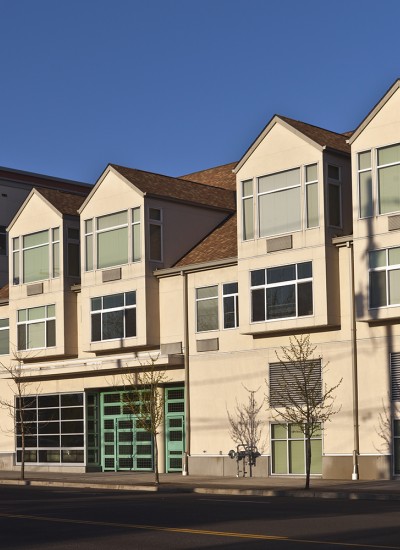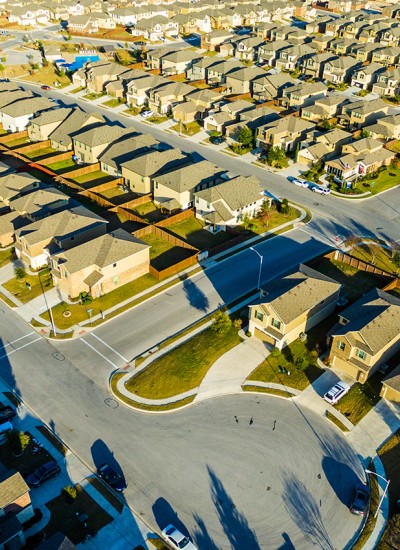By Mary Kyle McCurdy | 7-minute read
Every Oregonian deserves a safe and affordable place to call home in livable neighborhoods, but many of our fellow Oregonians do not have that because Oregon is short approximately 140,000 homes for people who are living here today. Most of the housing we’re missing is for people with moderate and lower incomes. That means people going without appropriate housing in Oregon include health care workers, baristas, mechanics, older people on fixed incomes, day-care providers, people experiencing homelessness, and more.
Our housing deficit will grow to approximately half million over the next 20 years unless we take bold, long-overdue actions now.
Oregon’s land use planning program plays a critical part in ensuring we have enough housing for all Oregonians. Thanks to land use requirements, there are tens of thousands of acres of buildable residential lands inside our towns and cities, near jobs, schools, and services. Now that land needs infrastructure investment to be unlocked for development.
Oregon’s policy, investment, and political efforts should now focus almost entirely on housing for people with moderate and lower incomes, by investing in building homes in places that reinforce affordable living, reduce climate change, and respect the environment.

Not all housing is equal
We can meet the housing needs of Oregonians – if we work smart within the land use system. But anyone who has ever struggled to find or afford a stable living space knows our housing crisis isn’t only about sheer numbers: What we build and where we build it is just as important.
About two-thirds of the Oregonians who need housing are people making less than 120 percent of the area median income (considered moderate or lower incomes). Meanwhile, the underproduction in housing is even more dramatically skewed: Ninety-five percent of the current housing underproduction is for people with moderate and lower incomes. (Housing is still very expensive and potentially out of reach if your income hovers slightly above 120 percent of AMI.)
If we attempt to meet the current housing needs of most of our fellow Oregonians by building primarily market-rate housing that only people with relatively higher incomes can afford, benefits will take a generation or more to trickle down enough to impact housing prices for people with lower incomes. Building market-rate housing now won’t meet the housing needs of Oregonians today.
Instead, we need to increase Oregon’s housing supply in livable, walkable neighborhoods for people with moderate and lower incomes in order to have an immediate impact for the people who need it most. We share the ambitious housing goals of Governor Kotek and the legislature, and that’s why Oregon must focus on bridging this gap, because the housing market won’t do it on its own.
Bulldozing the land use system won’t work
In the wake of House Bill 3414 failing in the 2023 legislative session, we anticipate that a similar bill will be back in 2024. Just how that will look is still being determined.
However, we know that some legislative concepts currently being considered focus on sidestepping land use laws to expand urban growth boundaries (UGBs), primarily to build private-sector, higher-income housing while offering a modest amount of housing for people with moderate and lower incomes from the private building sector. This strategy exacerbates existing infrastructure funding gaps; fails to make the most of the land we have; will take longer to build fewer homes than the same dollars invested in existing communities; places additional burdens on underserved and marginalized communities because homes at the edge are farther away from schools and stores; increases climate impacts and wildfire risk; and puts farmland and natural resources at risk.
[Update, February 6, 2024: SB 1537, the 2024 housing bill, has been introduced. Read our breakdown on the bill.]

Here’s what will work
Statewide land use planning Goal 10 – the housing goal – requires every city in Oregon to plan, zone, and use related tools to establish needed, diverse, and affordable housing choices for all, in every neighborhood, so that people have flexibility of choice and access. In years past, we have not effectively implemented Goal 10 at the local level, nor have we enforced Goal 10 at the state agency level, and new tools, like the Oregon Housing Needs Analysis, take the first great strides to correct this.
Through Goal 10 and the rest of the land use system, we can focus our efforts on solutions that will work.
Invest in infrastructure for housing, especially middle- and lower-income housing
Investing in infrastructure in our existing towns and cities is the most important step the state can take now to unlock large parcels of land to quickly produce housing for people with modest incomes. Today, there are well more than 10,000 acres of land inside Oregon’s urban growth boundaries that are zoned for residential development and are ready for housing – except the land lacks some or all infrastructure such as sewers, water, roads, and sidewalks. There are also great redevelopment opportunities that need a relatively small amount of infrastructure upgrades to bring thousands of homes, including affordable homes, well-located near stores, schools, and transit, such as Lloyd Center and Broadway Corridor in Portland.
Most cities lack the financial capacity to pay for these critical facilities. 1000 Friends and a broad spectrum of advocates and builders supported legislation in 2023 that would have created revolving loan and grant programs for infrastructure for moderate-income housing, which failed to pass. We will be supporting these efforts again in 2024 for moderate- and lower-income housing, with an even bigger coalition of supporters. We know Governor Kotek and many legislators agree, and we hope to get this across the finish line in 2024.
Fund housing for those making 60 percent and under area median income
Oregonians making well under the AMI – many of whom work more than one minimum-wage job, or live on a fixed income, or are raising children or caring for a parent – need our collective support to attain and maintain stable, affordable housing. Oregon must increase investments to preserve existing affordable housing, acquire buildings and land for additional housing, provide rental assistance to keep families in housing, and more.
Expand and incentivize housing production on underused parking lots and commercial lands and buildings
We have far more parking spaces for cars than we do housing for people, and as any trip through almost any Oregon town at any hour of the day will demonstrate, much of the surface parking lots are almost empty. This is environmentally damaging, causes heat islands, and creates inhospitable barriers to getting around communities. Many of these are great locations to redevelop with housing and local parks. Now, there’s even federal funding to convert these spaces.
Remove unnecessary local regulations to building housing where it is already allowed
Today, many local development regulations and procedures pose unnecessary and expensive hurdles to building housing inside our towns and cities. We should remove the unnecessary regulations while keeping those that make a neighborhood livable by protecting the natural resources, tree canopies, and air and water quality that are essential to healthy neighborhoods. The Department of Land Conservation & Development already has this underway with the Oregon Housing Needs Analysis program (OHNA), passed by the legislature in 2023.
Expand the range of housing types allowed in most neighborhoods
Oregon towns and cities should allow a greater diversity of housing in every neighborhood, such as garden apartments, cottage clusters, six- and eight-plexes, and smaller apartment buildings mixed with neighborhood stores and schools. This variety in development creates the convenient, healthy communities that everyone deserves to live in; it also allows new families to get started and older families to downsize in the same neighborhood.
HB 2001 gets us back on the housing track
What can you do now?
Use Oregon’s legislator lookup tool to find your state representative and senator, and let them know you support positive steps to deliver the housing Oregonians need, where they need it, and quickly through funding infrastructure for housing, and especially affordable housing. We also encourage you to reach out to your legislators at their local town halls and coffees – you can use the same legislator lookup tool to locate their contact information and sign up for updates. When you reach out, tell them you do not support the false promise of expanding UGBs. We’ll be doing the same when the 2024 legislation session kicks off.
